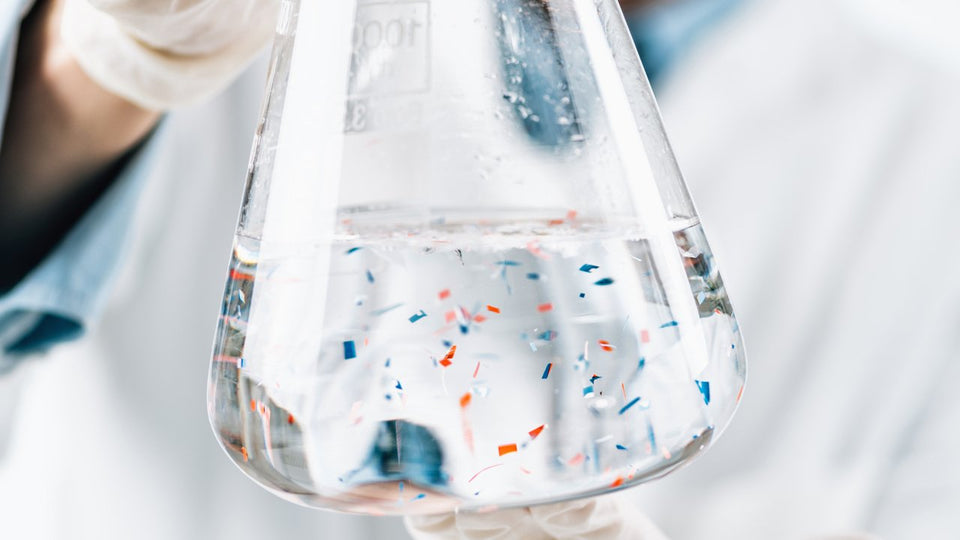What are Microplastics and why are they bad?

What are microplastics?
Scientists first discovered tiny pieces of plastic in the oceans in the 1970s, but the term “microplastic” wasn’t coined until 2004. Microplastics are tiny plastic particles that measure less than five millimeters in size and come in various forms. They can be categorized into two main types: primary microplastics and secondary microplastics. Primary microplastics are intentionally manufactured at a small size, such as microbeads in personal care products, and are designed for specific purposes like exfoliation or abrasive cleaning.
Secondary microplastics, on the other hand, result from the breakdown of larger plastic items over time due to weathering, UV radiation, and physical wear and tear. These larger plastic items, such as bottles, bags, and packaging materials, gradually fragment into smaller and smaller pieces over time, ultimately becoming microplastics. From there, they can break down even further into dust that’s impossible to remove from the environment. The ultra-tiny particles that make up this dust are called nanoplastics.
Due to their tiny size, microplastics can easily be distributed through the environment through processes like wind dispersal, soil erosion and runoff, wastewater treatment, and being eaten by fish and other creatures in the ecosystem.
Where do microplastics come from?
Humanity has created more than 8.4 billion tons of plastic in the last 60 years for various applications, and most of it hasn’t been recycled. Once these plastics have served their purpose and are discarded, they often end up in landfills or the ocean, where they degrade into smaller particles. Here are just a few sources of microplastics:
- Microbeads in personal care products
- Nurdles (pre-production plastic pellets)
- Microfibers from synthetic textiles
- Industrial abrasives containing microplastics
- Plastic debris from larger items
- Tire wear and tire dust
- Anti-fouling paints on boats and ships
- Plastic litter and discarded items
- Degradation of plastic waste in landfills
- Production of plastic dust through abrasion
- Weathering and UV degradation of plastics
- Breakdown of plastic packaging materials
- Disintegration of plastic bottles and containers
- Erosion of plastic-based outdoor equipment
- Release of microplastics during plastic manufacturing processes
Microplastics in drinking water
From plastic bags to single-use bottles to food containers, plastic enters our water sources every day through littering, irresponsible waste management, wastewater runoff, and more. According to the National Oceanic and Atmospheric Administration, more than eight million tons of discarded plastic makes its way into our waterways every year. A lot of plastic floats, meaning that as it breaks down over time, it’s going directly into our water.
Our municipalities are designed to disinfect your water before it reaches your home, mainly tackling contaminants like microorganisms (E. coli and giardia), inorganic chemicals (asbestos and arsenic), and other impurities that can cause serious health issues. Because microplastics are so small, the city is able to remove some of the unwanted contaminant, leaving it in our drinking water supply.
Health effects of microplastics
The health effects of microplastics have emerged as an area of growing concern. While the full extent of their impact on human health is still under investigation, several potential health risks have been identified. First, ingested microplastics can accumulate in the gastrointestinal tract and potentially lead to physical irritation, inflammation, or damage to the intestinal lining. Moreover, there is evidence to suggest that these tiny particles may act as carriers for harmful chemical pollutants, such as heavy metals and endocrine-disrupting chemicals. When microplastics are ingested, these contaminants can leach into the body, potentially causing systemic health issues.
The inhalation of airborne microplastics is another concern, particularly in urban areas where they may be present in dust and air pollution. Once inhaled, these particles could potentially reach the respiratory system and lead to respiratory problems. Although research is ongoing, it is clear that the pervasive presence of microplastics in the environment warrants further investigation into their potential health effects.
Everpure Filtration Products & Microplastics
Here is a link to nsf.org. Please scroll down to the bottom to find the current list of Everpure systems certified for microplastics reduction.
We also have a new series of filters NSF certified for the removal of Forever Chemicals, of which microplastics falls under.



